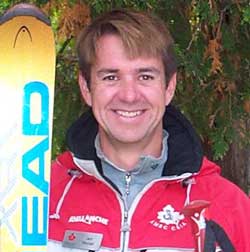Alpine Snow School - Ski
 |
Snow School Director: |
|
 |
Alpine Technical Director: We are pleased to have Jeff Sinclair returning as our Technical Director. Jeff has a Level IV CSIA and Level II CSCF, and is big addition to the club. |
|
SPECIALIZED SKI CLINIC DAYS
Over the course of the season, we will be offering some specialized ski clinics in racing, carving and mogul skiing. These clinics will be open to any intermediate skier or above, and will be offered in place of the regular day trip lesson on the specified dates. There is no need to pre book for these clinics. Just express interest at the morning line up.
CLINIC |
DATES |
Location |
Skill Level |
| Racing/Gates | Sat. Jan. 16th, 2010 |
Mount St Louis/Moonstone |
Advanced |
| Racing/Gates | Sat. Jan. 24th, 2010 |
Mount St Louis/Moonstone |
Intermediate |
| Racing/Gates | Sun. Jan. 31st, 2010 |
Mount St Louis/Moonstone |
Advanced |
| Racing/Gates | Sun. Feb. 7th, 2010 |
Mount St Louis/Moonstone |
Intermediate |
| Racing/Gates | Sat. Feb.13th, 2010 |
Mount St Louis/Moonstone |
Beginner |
| Racing/Gates | Sun. Feb. 21st, 2010 |
Mount St Louis/Moonstone |
Beginner |
Also keep your eye on the weekly email update for more clinic announcements.
NTSC STEP PROGRAM FOR CLASSES
Don't know what class STEP level to go in? Your level will be assessed in a brief interview and possibly a short ski with an instructor. This level number will be used to group you with other skiers of similar ability. NTSC’s STEP Evaluation program for classes is made up ten steps for skiers.
Requirements For Student Promotion are the criteria to graduate from that STEP level into the next. Students should be able to demonstrate the skill requirements during most of the 2 hour lesson before progressing to the next STEP level.
| STEP | REQUIREMENTS FOR STUDENT PROMOTION |
1 |
Consistently link wedge type turns, on beginner terrain.
|
2 |
Match the skis parallel at the end of the turn, on novice (green) terrain.
|
3 |
Ski parallel through the last ½ of the turn, on novice (green) terrain.
|
4 |
Ski intermediate (blue) terrain with rhythm & edge control, but still using a slight wedge.
|
5 |
Make consistent parallel turns with a consistent pole plant on intermediate (blue) terrain.
|
6 |
Make consistent parallel turns, with rhythm & edge control, on intermediate (blue) terrain.
|
7 |
Make consistent parallel turns, with rhythm & edge control, on intermediate (blue) and some advanced (black) terrain.
|
8 |
Dynamic, rhythmical shorter radius parallel turns (consistent symmetrical turns) on advanced (black) terrain.
|
9 |
Link parallel turns in bumps on intermediate (blue) & some advanced (black) terrain.
|
10 |
Dynamic parallel turns, with rhythm, speed & control on advanced (black) & some expert varied terrain.
|
STUDENT PROMOTIONS
Each student will be given a blue STUDENT PROGRESS BOOK the first time they take a lesson. Your progress book will be used by the instructors during the season to record your skill development at the end of each lesson you take.
When do I get promoted into the next STEP level?
Requirements For Student Promotion (see table above) are the criteria to graduate from that STEP level into the next. Students should be able to demonstrate the skill requirements during most of the 2 hour lesson before progressing to the next STEP level.
The protocol that will be used by instructors to verify student promotion will be as follows:
|
To Promote a Student
|
No. of Instructor(s) Signing
STUDENT PROGRESS BOOK for Promotion |
|
|
From
|
To
|
|
|
Never Ever
|
STEP 1
|
1
|
|
STEP 1
|
STEP 2
|
|
|
STEP 2
|
STEP 3
|
|
|
STEP 3
|
STEP 4
|
|
|
STEP 4
|
STEP 5
|
|
|
STEP 5
|
STEP 6
|
2
|
|
STEP 6
|
STEP 7
|
|
|
STEP 7
|
STEP 8
|
|
|
STEP 8
|
STEP 9
|
|
|
STEP 9
|
STEP 10
|
|
Whenever possible, assessments for promotion will be conducted as part of a regular morning lesson and will be verified in your next lesson. .
Questions? Email : skischool@northtorontoskiclub.com